Kamis, 31 Maret 2022
Watch: US astronaut, two Russian cosmonauts share ride back to earth amid tensions over Ukraine - Hindustan Times
https://news.google.com/__i/rss/rd/articles/CBMiK2h0dHBzOi8vd3d3LnlvdXR1YmUuY29tL3dhdGNoP3Y9OVJQNm45WmdlWUnSAQA?oc=5
2022-03-31 06:42:12Z
1356776659
Rabu, 30 Maret 2022
Hubble Space Telescope spots the most distant star ever seen - CBC News
Astronomers have discovered the farthest star yet, a super-hot, super-bright giant that formed nearly 13 billion years ago at the dawn of the cosmos.
But this luminous blue star is long gone, so massive that it almost certainly exploded into bits just a few million years after emerging. Its swift demise makes it all the more incredible that an international team spotted it with observations by the Hubble Space Telescope. It takes eons for light emitted from distant stars to reach us.
"We're seeing the star as it was about 12.8 billion years ago, which puts it about 900 million years after the Big Bang," said astronomer Brian Welch, a doctoral student at Johns Hopkins University and lead author of the study appearing in the journal Nature on Wednesday.
"We definitely just got lucky."
He nicknamed it Earendel, an Old English name that means morning star or rising light — "a fitting name for a star that we have observed in a time often referred to as `Cosmic Dawn.'"

The previous record-holder, Icarus, also a blue supergiant star spotted by Hubble, formed 9.4 billion years ago. That's more than four billion years after the Big Bang.
In both instances, astronomers used a technique known as gravitational lensing to magnify the minuscule starlight. Gravity from clusters of galaxies closer to us — in the foreground — serve as a lens to magnify smaller objects in the background. If not for that, Icarus and Earendel would not have been discernible given their vast distances.
'A gift ... from the universe'
While Hubble has spied galaxies as far away as 300 million to 400 million years of the universe-forming Big Bang, their individual stars are impossible to pick out.
"Usually they're all smooshed together.... But here, nature has given us this one star — highly, highly magnified, magnified by factors of thousands — so that we can study it," said NASA astrophysicist Jane Rigby, who took part in the study. "It's such a gift really from the universe."
Vinicius Placco of the National Science Foundation's NOIRLab in Tucson, Ariz., described the findings as "amazing work." He was not involved in the study.
Placco said based on the Hubble data, Earendel may well have been among the first generation of stars born after the Big Bang. Future observations by the newly launched James Webb Space Telescope should provide more details, he said, and "provide us with another piece of this cosmic puzzle that is the evolution of our universe."
WATCH | Record broken: Hubble spots farthest star ever seen:
Current data indicates Earendel was more than 50 times the size of our sun and an estimated one million times brighter, outsizing Icarus. Earendel's small, yet-to-mature home galaxy looked nothing like the pretty spiral galaxies photographed elsewhere by Hubble, according to Welch, but rather "kind of an awkward-looking, clumpy object." Unlike Earendel, he said, this galaxy probably has survived, although in a different form after merging with other galaxies.
"It's like a little snapshot in amber of the past," Rigby said.
Earendel may have been the prominent star in a two-star, or binary, system, or even a triple- or quadruple-star system, Welch said. There's a slight chance it could be a black hole, although the observations gathered in 2016 and 2019 suggest otherwise, he noted.
Regardless of its company, the star lasted barely a few million years before exploding as a supernova that went unobserved, as most do, Welch said. The most distant supernova seen by astronomers to date goes back 12 billion years.
The Webb telescope — 100 times more powerful than Hubble — should help clarify how massive and hot the star really is, and reveal more about its parent galaxy.
By studying stars, Rigby said: "We are literally understanding where we came from because we're made up of some of that stardust."
https://news.google.com/__i/rss/rd/articles/CBMiSGh0dHBzOi8vd3d3LmNiYy5jYS9uZXdzL3NjaWVuY2UvaHViYmxlLXRlbGVzY29wZS1mYXJ0aGVzdC1zdGFyLTEuNjQwMjg4OdIBAA?oc=5
2022-03-30 21:28:04Z
1363418813
US astronaut ends record-long spaceflight in Russian capsule – Victoria News - Victoria News

A NASA astronaut caught a Russian ride back to Earth on Wednesday after a U.S. record 355 days at the International Space Station, returning with two cosmonauts to a world torn apart by war.
Mark Vande Hei landed in a Soyuz capsule in Kazakhstan alongside the Russian Space Agency’s Pyotr Dubrov, who also spent the past year in space, and Anton Shkaplerov. Wind blew the capsule onto its side following touchdown, and the trio emerged into the late afternoon sun one by one.
Vande Hei, the last one out, grinned and waved as he was carried to a reclining chair out in the open Kazakh steppes.
“Beautiful out here,” said Vande Hei, putting on a face mask and ballcap.
Despite escalating tensions between the U.S. and Russia over Vladimir Putin’s war with Ukraine, Vande Hei’s return followed customary procedures. A small NASA team of doctors and other staff was on hand for the touchdown and planned to return immediately to Houston with the 55-year-old astronaut.
Even before Russia’s Feb. 24 invasion of Ukraine, Vande Hei said he was avoiding the subject with his two Russian crewmates. Despite getting along “fantastically … I’m not sure we really want to go there,” he said.
It was the first taste of gravity for Vande Hei and Dubrov since their Soyuz launch on April 9 last year. Shkaplerov joined them at the orbiting lab in October, escorting a Russian film crew up for a brief stay. To accommodate that visit, Vande Hei and Dubrov doubled the length of their stay.
Before departing the space station, Shkaplerov embraced his fellow astronauts as “my space brothers and space sister.”
“People have problem on Earth. On orbit … we are one crew,” Shkaplerov said in a live NASA TV broadcast Tuesday. The space station is a symbol of “friendship and cooperation and … future of exploration of space.”
The war tensions bubbled over in other areas of space with the suspension of European satellite launches on Russian rockets and the Europe-Russia Mars rover stuck on Earth for another two years.
Vande Hei surpassed NASA’s previous record for the longest single spaceflight by 15 days. Dubrov moved into Russia’s top five, well short of the 437-day, 17-hour marathon by a cosmonaut-physician aboard the 1990s Mir space station that remains the world record.
“Broken records mean we’re making progress,” said NASA’s previous space endurance champ, retired astronaut Scott Kelly, whose 340-day mission ended in 2016.
Like Kelly, Vande Hei underwent medical testing during his long stay to further NASA’s quest to get astronauts back to the moon and on to Mars. He said daily meditation helped him cope during the mission, twice as long as his first station stint four years earlier.
“I’ve had an indoor job 24-7 for almost a year so I am looking forward to being outside no matter what kind of weather,” Vande Hei said in a recent series of NASA videos. As for food, he’s looking forward to making a cup of coffee for himself and wife Julie, and digging into guacamole and chips.
Remaining on board: Three Russians who arrived two weeks ago and three Americans and one German, who have been aboard since November. Their replacements are due in three weeks via SpaceX. Next week, SpaceX will fly three rich businessmen and their ex-astronaut escort to the station for a weeklong visit arranged by the private Axiom Space.
Elon Musk’s SpaceX began transporting NASA astronauts to the station in 2020, nine years after the shuttle program ended. During that gap, Russia offered the lone taxi service, with NASA shelling out tens of millions of dollars per Soyuz seat. Vande Hei’s ride was part of a barter exchange with Houston-based Axiom.
—Marcia Dunn, The Associated Press
RELATED: Space travel can improve everyone’s lives, says Canadian astronaut Chris Hadfield
https://news.google.com/__i/rss/rd/articles/CBMiWmh0dHBzOi8vd3d3LnZpY25ld3MuY29tL25ld3MvdXMtYXN0cm9uYXV0LWVuZHMtcmVjb3JkLWxvbmctc3BhY2VmbGlnaHQtaW4tcnVzc2lhbi1jYXBzdWxlL9IBAA?oc=5
2022-03-30 19:30:00Z
1356776659
CHIME Outrigger telescopes boost search for fast radio bursts - McGill Newsroom

In the quest to identify the origins of one of astronomy’s biggest mysteries – fast radio bursts (FRBs) – Canada’s world-renowned telescope, the Canadian Hydrogen Intensity Mapping Experiment (CHIME), is getting backup.
Supported by approximately $10 million in grants from the Gordon and Betty Moore Foundation, the CHIME/FRB Outriggers project has now secured funding to complete the construction of three new radio telescopes to work in conjunction with the main CHIME instrument, located in British Columbia’s Okanagan Valley.
“It has been a pleasure to work with the talented team developing the outriggers for CHIME,” said Robert Kirshner, Ph.D., Chief Program Officer for Science at the Gordon and Betty Moore Foundation. “Despite the burdens of COVID, interruptions in the supply of steel for the antennas, and competition with bitcoin miners for the specialized computer chips that power their computational wizardry, the CHIME team is headed toward a spectacular improvement in the scientific yield of CHIME’s copious FRB discoveries.”
Outriggers to sharpen CHIME’s vision
With the ability to detect 10-100 times more fast radio bursts than all other telescopes combined, CHIME has had a radical impact on FRB science. The telescope has allowed scientists to observe the vanishingly brief bursts with exquisite time resolution. CHIME’s limitation, however, has been its inability to identify with any precision where the FRBs were coming from. The outriggers will enable this radical leap.
“The CHIME telescope can currently locate the position of a fast radio burst to a patch of sky equivalent to the size of the full Moon. With the addition of the three new outrigger telescopes, this patch of sky can be reduced to the size of a quarter held at roughly 40 km,” explained Patrick Boyle, Senior Project Manager for the CHIME/FRB Outriggers project and Senior Academic Associate in the Department of Physics at McGill University.
By pinpointing FRBs, the new telescopes will allow scientists to zoom in on the environments within galaxies from which the bursts originate and, in so doing, narrow down the possible explanations for their existence.
“The CHIME/Outrigger Fast Radio Burst team is poised to shed even more light on one of the Universe’s most exciting recent discoveries: the fleeting pulses known as fast radio bursts (FRBs),” said lead CHIME/FRB researcher Prof. Victoria Kaspi, Director of the McGill Space Institute and Professor of Physics at McGill University. “The CHIME outrigger telescopes will help us to both understand the origins of FRBs and realize their potential as cosmic probes.”
CHIME’s new siblings
The outrigger telescopes are smaller versions of the original set to be built in three locations across North America. One of the outrigger sites is in Canada:
- Near Princeton, British Columbia, on land kindly leased to CHIME by HML Mining Ltd., where construction of the new telescope’s reflector has already been completed
The other two are in the United States and result from partnerships with existing radio astronomy observatories:
- The Green Bank Observatory in West Virginia, where it sits in the middle of the National Radio Quiet Zone (NRQZ).
- The Hat Creek Radio Observatory in California, where the CHIME/FRB project has partnered with the SETI Institute.
“Green Bank Observatory’s distance from the other CHIME locations, being within the NRQZ and the pre-existing infrastructure available on our campus make this the perfect site for a new CHIME Outrigger. The instrument will benefit from the protections of radio frequency interference that the NRQZ provides. It is good to see our extensive 2,700 acre campus being used in new ways, and it is exciting to see this impressive instrument under construction,” said Andrew Seymour, a Green Bank Observatory scientist working with the CHIME team on the project.
“We are thrilled to welcome the world-class CHIME team to the Hat Creek Radio Observatory,” said Andrew Siemion, Bernard M. Oliver Chair for SETI at the SETI Institute. “Hosting a CHIME outrigger represents a phenomenal and complementary addition to the HCRO’s science mission.”
Building on a successful collaboration
Representing an amazing convergence of scientists across North America, the CHIME/FRB Outriggers project is a collaboration between several Canadian and international institutes, including McGill University, the University of British Columbia, the University of Toronto, West Virginia University, and the Massachusetts Institute of Technology. Also partnering on the project is the Perimeter Institute for Theoretical Physics, the National Research Council of Canada, the National Radio Astronomy Observatory, and the Green Bank Observatory.
The outrigger project has also received funding by the National Science Foundation (NSF) for the electronics as well as salaries for faculty, postdocs and graduate students located in the United States.
About the Gordon and Betty Moore Foundation
The Gordon and Betty Moore Foundation fosters path-breaking scientific discovery, environmental conservation, patient care improvements and preservation of the special character of the Bay Area. Visit moore.org and follow @MooreFound.
About the Green Bank Observatory
The Green Bank Observatory is a major facility of the National Science Foundation administered by Associated University, Inc.
About the SETI Institute
Founded in 1984, the SETI Institute is a non-profit, multi-disciplinary research and education organization whose mission is to lead humanity's quest to understand the origins and prevalence of life and intelligence in the universe and share that knowledge with the world. Our research encompasses the physical and biological sciences and leverages data analytics, machine learning, and advanced signal detection technologies. The SETI Institute is a distinguished research partner for industry, academia, and government agencies, including NASA and the National Science Foundation.
About McGill University
Founded in Montreal, Quebec, in 1821, McGill University is Canada’s top ranked medical doctoral university. McGill is consistently ranked as one of the top universities, both nationally and internationally. It is a world-renowned institution of higher learning with research activities spanning three campuses, 11 faculties, 13 professional schools, 300 programs of study and over 39,000 students, including more than 10,400 graduate students. McGill attracts students from over 150 countries around the world, its 12,000 international students making up 30% of the student body. Over half of McGill students claim a first language other than English, including approximately 20% of our students who say French is their mother tongue.
For media requests, please contact:
McGill University: Fergus Grieve, Communications Officer, fergus.grieve [at] mcgill.ca
Gordon and Betty Moore Foundation: Trity Pourbahrami, Communications Officer, Science Program, trityp [at] moore.org
Green Bank Observatory: Jill Malusky, Public Relations, jmalusky [at] nrao.edu
SETI Institute: Rebecca McDonald, Director of Communications, mcdonald [at] seti.org
https://news.google.com/__i/rss/rd/articles/CBMibWh0dHBzOi8vd3d3Lm1jZ2lsbC5jYS9uZXdzcm9vbS9jaGFubmVscy9uZXdzL2NoaW1lLW91dHJpZ2dlci10ZWxlc2NvcGVzLWJvb3N0LXNlYXJjaC1mYXN0LXJhZGlvLWJ1cnN0cy0zMzg3NjbSAQA?oc=5
2022-03-30 16:07:15Z
CAIiEKrheUhLEqVIhM6WlXDtXpQqMwgEKioIACIQwKKbrP_l0kTob0bon-56nioUCAoiEMCim6z_5dJE6G9G6J_uep4wqOnmBg
COVID: Wildlife the latest frontier in coronavirus fight - CTV News

GRAND PORTAGE, MINN. -- To administer this COVID test, Todd Kautz had to lay on his belly in the snow and worm his upper body into the narrow den of a hibernating black bear. Training a light on its snout, Kautz carefully slipped a long cotton swab into the bear’s nostrils five times.
For postdoctoral researcher Kautz and a team of other wildlife experts, tracking the coronavirus means freezing temperatures, icy roads, trudging through deep snow and getting uncomfortably close to potentially dangerous wildlife.
They’re testing bears, moose, deer and wolves on a Native American reservation in the remote north woods about 5 miles from Canada. Like researchers around the world, they are trying to figure out how, how much and where wildlife is spreading the virus.
Scientists are concerned that the virus could evolve within animal populations, potentially spawning dangerous viral mutants that could jump back to people, spread among us and reignite what for now seems to some people like a waning crisis.
The coronavirus pandemic has served as a stark and tragic example of how closely animal health and human health are linked. While the origins of the virus have not been proven, many scientists say it likely jumped from bats to humans, either directly or through another species that was being sold live in Wuhan, China.
And now the virus has been confirmed in wildlife in at least 24 U.S. states, including Minnesota. Recently, an early Canadian study showed someone in nearby Ontario likely contracted a highly mutated strain from a deer.
“If the virus can establish itself in a wild animal reservoir, it will always be out there with the threat to spill back into the human population,” said University of Minnesota researcher Matthew Aliota, who is working with the Grand Portage Reservation team.
E.J. Isaac, a fish and wildlife biologist for the reservation that's home to the Grand Portage Ojibwe, said he expects the stakes to get even higher with the start of spring, as bears wake from hibernation and deer and wolves roam to different regions.
“If we consider that there are many species and they’re all intermingling to some extent, their patterns and their movements can exponentially increase the amount of transmission that could occur,” he said.
INTO THE WILD
Their research is meant to ward off such unwelcome surprises. But it carries its own set of risks.
Seth Moore, who directs the reservation biology and environment department, recently almost got bitten by a wolf.
And they sometimes team with a crew from the Texas-based company Heliwild to capture animals from the air. One chilly late-winter afternoon, the men climbed into a small helicopter with no side doors that lifted above the treetops. Flying low, they quickly spotted a deer in a forest clearing. They targeted the animal from the air with a net gun and dropped Moore off.
Wind whipped at his face as he worked in deep snow to quickly swab the deer’s nose for COVID, put on a tracking collar and collect blood and other biological samples for different research.
The men capture moose in much the same way, using tranquilizer darts instead of nets. They trap wolves and deer either from the air or on the ground, and trap bears on the ground.
They knew of the young male bear they recently tested because they had already been tracking it. To get to the den, they had to take snowmobiles to the bottom of a hill then hike a narrow, winding path in snow shoes.
When Kautz crawled part-way into the den, a colleague held his feet to pull him out quickly if necessary. The team also gave the animal a drug to keep it sleeping and another later to counteract the effects of the first.
To minimize the risk of exposing animals to COVID, the men are fully vaccinated and boosted and get tested frequently.
The day after testing the bear, Isaac packed their samples to send to Aliota’s lab in Saint Paul. The veterinary and biomedical researcher hopes to learn not just which animals are getting infected but also whether certain animals are acting as “bridge species” to bring it to others. Testing may later be expanded to red foxes and racoons.
It’s also possible the virus hasn’t reached this remote location – yet. Since it’s already circulating in the wilderness of Minnesota and nearby states, Aliota said it’s only a matter of time.
LOOKING FOR MUTANTS
Close contact between humans and animals has allowed the virus to overcome built-in barriers to spread between species.
To infect any living thing, the virus must get into its cells, which isn’t always easy. Virology expert David O’Connor likens the process to opening a “lock” with the virus’ spike protein “key.”
“Different species have different-looking locks, and some of those locks are not going to be pickable by the key,” the University of Wisconsin-Madison scientist said.
But other locks are similar enough for the virus to enter an animal’s cells and make copies of itself. As it does, it can randomly mutate and still have a key that fits in the human lock. That allows it to leap back to humans through close contact with live animals, scientists believe.
Although spillback is rare, it only takes one person to bring a mutated virus into the realm of humans.
Some think the highly mutated Omicron variant emerged from an animal rather than an immune-compromised human, as many believe. Virologist Marc Johnson of the University of Missouri is one of them, and now sees animals as “a potential source of pi,” the Greek letter that may be used to designate the next dangerous coronavirus variant.
Johnson and his colleagues found strange coronavirus lineages in New York City sewage with mutations rarely seen elsewhere, which he believes came from animals, perhaps rodents.
What scientists are most concerned about is that current or future variants could establish themselves and multiply widely within a reservoir species.
One possibility: white-tailed deer. Scientists found the coronavirus in a third of deer sampled in Iowa between September 2020 and January 2021. Others found COVID-19 antibodies in a third of deer tested in Illinois, Michigan, New York and Pennsylvania. Infected deer generally have no symptoms. Testing in many other wild species has been limited or absent.
“It’s possible that the virus is already perhaps circulating in multiple animals,” said virology expert Suresh Kuchipudi of Pennsylvania State University, an author of the Iowa deer study. If unmonitored, the virus could leave people “completely blindsided,” he said.
CAN IT BE STOPPED?
Ultimately, experts say the only way to stop viruses from jumping back and forth between animals and humans — extending this pandemic or sparking a new one — is to tackle big problems like habitat destruction and illegal wildlife sales.
“We are encroaching on animal habitats like we have never before in history,” Aliota said. “Spillover events from wild animals into humans are, unfortunately I think, going to increase in both frequency and scope.”
To combat that threat, three international organizations — the United Nations Food and Agriculture Organization, the World Organization for Animal Health and the World Health Organization — are urging countries to make COVID surveillance in animals a priority.
In Grand Portage, Aliota’s collaborators continue to do their part by testing as many animals as they can catch.
With icy Lake Superior sparkling through the evergreens, Isaac slipped his hand beneath the netting of a deer trap. A colleague straddling the animal lifted its head off the snowy ground so that Isaac could swab its nostrils.
The young buck briefly lurched its head forward, but kept still long enough for Isaac to get what he needed.
“Nicely done,” his colleague said as Isaac put the sample into a vial.
When they were finished, they gently lifted the trap to let the deer go. It bounded into the vast forest without looking back, disappearing into the snowy shadows.
___
The Associated Press Health and Science Department receives support from the Howard Hughes Medical Institute’s Department of Science Education. The AP is solely responsible for all content.
https://news.google.com/__i/rss/rd/articles/CBMiZmh0dHBzOi8vd3d3LmN0dm5ld3MuY2EvaGVhbHRoL2Nvcm9uYXZpcnVzL3dpbGQtYW5pbWFscy10aGUtbGF0ZXN0LWZyb250aWVyLWluLWNvdmlkLTE5LWZpZ2h0LTEuNTg0MDU2NtIBAA?oc=5
2022-03-30 07:39:40Z
CAIiEKD0ImLEl6N9TsUvU1fJHyYqGQgEKhAIACoHCAow6f-ICzDjj4gDMLHozAY
Sabtu, 26 Maret 2022
This SCARY Asteroid almost hit Earth, came dangerously close just 24 hours ago - HT Tech
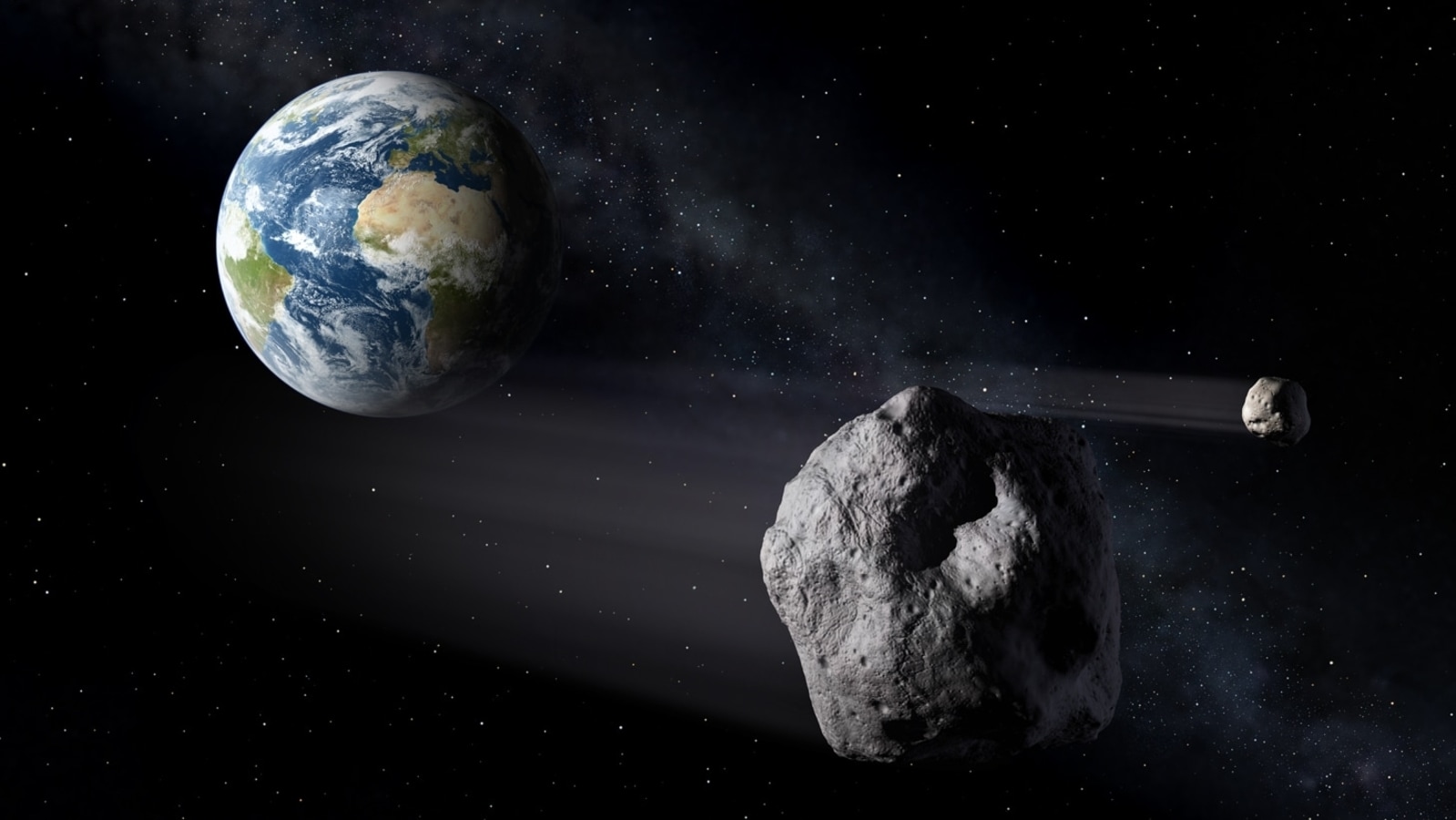
The same astronomer who discovered an asteroid two hours before impact, has discovered another asteroid just hours before it came extremely close to striking the Earth.
A very dangerous thing has happened yet again! The same astronomer who last week discovered 2022 EB5 hours before it actually hit the Earth near western Greenland coast, has discovered yet another scary asteroid. Thankfully, asteroid strike on Earth was averted this time as it flew past our planet, but not before coming dagerously close to Earth. On the night of March 25, Hungarian astronomer Krisztian Sarneczky found a new asteroid while stargazing. The asteroid was discovered merely hours before it flew horrifyingly close to Earth. The distance between this asteroid and Earth was merely 8,700 km! That is even less than the distance between GPS satellites up in the sky and Earth. The asteroid was briefly nicknamed SAR2594 by the astronomer, but has been labeled as 2022 FD1 for organized astronomical classification.
Sarneczky took it to Twitter to announce his discovery. In a post, he wrote, “Almost. Again :-) My newly discovered asteroid #Sar2594 will pass cca. 15,100 km from Earth around 09:10 UT. Minus Earth radius = 8,700 km above the surface. Almost”. The astronomer who goes by ‘asteroid hunter’ on the micro-blogging website has been prolific in recent times in discovering these celestial objects. He also accurately calculated that asteroid 2022 FD1 was going to pass through the Earth’s shadow before any major space observatories.
Asteroid comes dangerously close to hitting the Earth
Even as the moment is quite special to the astronomer, it should not be forgotten that if the asteroid made an impact, it could have easily spelled disaster for many. While the size of the asteroid was not large at 2-4 meters, it was traveling at an extremely high speed of 40,265 miles an hour. For reference, it is almost 40 times the speed of sound. At such a speed, even an asteroid strike to the surface of the Earth was improbable, it could have caused a sonic blast and resulted in large damage in an urban setting. The scariest part is that if it was not for Sárneczky, the asteroid might have gone unnoticed entirely.
And these fears are not without merit. The astronomer also tweeted that the asteroid changed its inclination as it crossed the Earth due to our planet’s gravitational force. If it deviated any more, it could have even hit the Earth. Interestingly, asteroid 2022 FD1 has been registered as the 13th closest approach of a near-Earth object (NEO), that has not made an impact, in the NASA database. That means there are only 12 other asteroids which have ever come closer to Earth and not caused an asteroid strike to Earth.
https://news.google.com/__i/rss/rd/articles/CBMiiwFodHRwczovL3RlY2guaGluZHVzdGFudGltZXMuY29tL3RlY2gvbmV3cy90aGlzLXNjYXJ5LWFzdGVyb2lkLWFsbW9zdC1oaXQtZWFydGgtY2FtZS1kYW5nZXJvdXNseS1jbG9zZS1qdXN0LTI0LWhvdXJzLWFnby03MTY0ODI4MTM3NDMxMi5odG1s0gEA?oc=5
2022-03-26 07:58:42Z
1156491584
Jumat, 25 Maret 2022
Speeding Asteroid Spotted Flying Closer to Earth Than GPS Satellites - CNET
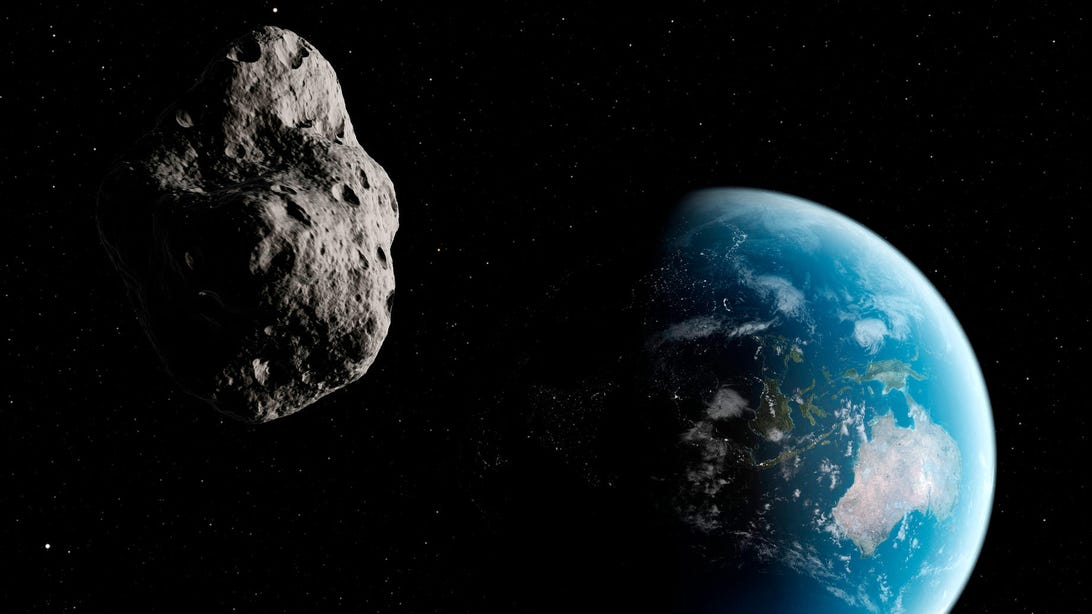
Astronomers are spotting near-Earth objects more frequently.
NASAThe same astronomer who recently discovered a small asteroid just a few hours before it smashed into our atmosphere has spotted another space rock whizzing right over humanity's heads.
Krisztián Sárneczky announced his discovery on Twitter late Thursday, mere hours before asteroid 2022 FD1 (it was briefly nicknamed SAR2594) passed within about 5,400 miles (8,700 kilometers) of our planet's surface.
For some perspective, GPS satellites fly in a medium Earth orbit at an altitude of 12,550 miles. The asteroid didn't come close enough to threaten the nearest humans, aboard the International Space Station at an altitude of 250 miles.
Several other astronomers around the world were also able to observe the asteroid as it buzzed by at over 38,000 miles per hour (61,200 kilometers per hour). It appears to be about the size of a refrigerator, just like the asteroid Sárneczky spotted in its final hours before it burned up somewhere over Iceland.
Asteroid 2022 FD1 goes down as the 13th closest approach of a near-Earth object (without impact, that is) on record in NASA's database. These records are skewed a bit toward more recent observations as technology has improved in recent decades and allowed astronomers to spot more and smaller objects in our immediate cosmic neighborhood.
https://news.google.com/__i/rss/rd/articles/CBMiaGh0dHBzOi8vd3d3LmNuZXQuY29tL3NjaWVuY2Uvc3BhY2Uvc3BlZWRpbmctYXN0ZXJvaWQtc3BvdHRlZC1mbHlpbmctY2xvc2VyLXRvLWVhcnRoLXRoYW4tZ3BzLXNhdGVsbGl0ZXMv0gEA?oc=5
2022-03-25 16:35:00Z
1156491584
Astronomers Reveal Remarkable Simulations of the Early Universe From the Dark Ages Through First Light - City Life Org

Still image from a Thesan simulation showing the universe 251 million years after the Big Bang. The orange halos represent the burst of radiation, or light, outpouring from early galaxies. Credit: Thesan Collaboration
New High-Resolution Simulations Show 1 Million Galaxies Forming Some 13 Billion Years Ago
It looks like fireflies flickering in the darkness. Slowly, more and more amass, lighting up the screen in large chunks and clusters.
But this is not a video about insects. It is a simulation of the early universe, a time after the Big Bang when the cosmos transformed from a place of utter darkness to a radiant, light-filled environment.
The stunning video is part of a large suite of simulations described in a series of three papers accepted to the Monthly Notices of the Royal Astronomical Society. Created by researchers at the Center for Astrophysics | Harvard & Smithsonian, the Massachusetts Institute of Technology (MIT) and the Max Planck Institute for Astrophysics, the simulations represent a monumental advancement in simulating the formation of the first galaxies and reionization—the process by which neutral hydrogen atoms in space were transformed into positively charged, or ionized, hydrogen, allowing light to spread throughout the universe.
The simulated period, known as the epoch of reionization, took place some 13 billion years ago and was challenging to reconstruct, as it involves immensely complicated, chaotic interactions, including those between gravity, gas and radiation, or light.
“Most astronomers don’t have labs to conduct experiments in,” said Rahul Kannan, an astrophysicist at the Center for Astrophysics and the lead author of the first paper in the series. “The scales of space and time are too large, so the only way we can do experiments is on computers. We are able to take basic physics equations and governing theoretical models to simulate what happened in the early universe.”
The team’s simulations—named Thesan after the Etruscan goddess of dawn—resolve interactions in the early universe with the highest detail and over the largest volume of any previous simulation. Physics in the early universe are captured down to scales that are a million times smaller than the simulated regions, providing unprecedented detail on properties of early galaxies and how light from these galaxies impacted gas.
The team accomplishes this by combining a realistic model of galaxy formation with a new algorithm that tracks how light interacts with gas, along with a model for cosmic dust.
With Thesan, researchers can simulate a piece of the universe spanning over 300 million light years across. The team can run the simulation forward in time to track and visualize the first appearance and evolution of hundreds of thousands of galaxies within this space, beginning around 400,000 years after the Big Bang, and through the first billion years.
The simulations reveal a gradual change in the universe from complete darkness to light.
“It’s a bit like water in ice cube trays; when you put it in the freezer, it does take time, but after a while it starts to freeze on the edges and then slowly creeps in,” said study co-author Aaron Smith, a NASA Einstein Fellow in MIT’s Kavli Institute for Astrophysics and Space Research. “This was the same situation in the early universe—it was a neutral, dark cosmos that became bright and ionized as light began to emerge from the first galaxies.”
The simulations were created to prepare for observations from the James Webb Space Telescope (JWST), which will be able to peer further back in time—approximately 13.5 billion years—than predecessors like the Hubble Space Telescope.
“A lot of telescopes coming online, like the JWST, are specifically designed to study this epoch,” Kannan said. “That’s where our simulations come in; they are going to help us interpret real observations of this period and understand what we’re seeing.”
Real telescope observations and data will soon be compared to Thesan simulations, the team said.
“And that’s the interesting part,” said study co-author Mark Vogelsberger, an associate professor of physics at MIT. “Either our Thesan simulations and model will agree with what JWST finds, which would confirm our picture of the universe, or there will be a significant disagreement showing that our understanding of the early universe is wrong.”
The team, however, will not know how various aspects of their model fares until the first observations roll in, which will cover a wide range of topics, including galaxy properties and the absorption and escape of light in the early universe.
“We have developed simulations based on what we know,” Kannan said. “But while the scientific community has learned a lot in recent years, there is still quite a bit of uncertainty, especially in these early times when the universe was very young.”
The simulations were created using one of the world’s largest supercomputers, the SuperMUC-NG, over the course of 30 million CPU-hours. The same simulations would have required more than 3,500 years to complete on a normal computer.
Additional scientists who make up the Thesan team are Lars Hernquist of the Center for Astrophysics and Enrico Garaldi, Ruediger Pakmor and Volker Springel of the Max Planck Institute for Astrophysics.
About the Center for Astrophysics | Harvard & Smithsonian
The Center for Astrophysics | Harvard & Smithsonian is a collaboration between Harvard and the Smithsonian designed to ask—and ultimately answer—humanity’s greatest unresolved questions about the nature of the universe. The Center for Astrophysics is headquartered in Cambridge, Massachusetts, with research facilities across the U.S. and around the world.
https://news.google.com/__i/rss/rd/articles/CBMiigFodHRwczovL3RoZWNpdHlsaWZlLm9yZy8yMDIyLzAzLzI1L2FzdHJvbm9tZXJzLXJldmVhbC1yZW1hcmthYmxlLXNpbXVsYXRpb25zLW9mLXRoZS1lYXJseS11bml2ZXJzZS1mcm9tLXRoZS1kYXJrLWFnZXMtdGhyb3VnaC1maXJzdC1saWdodC_SAY4BaHR0cHM6Ly90aGVjaXR5bGlmZS5vcmcvMjAyMi8wMy8yNS9hc3Ryb25vbWVycy1yZXZlYWwtcmVtYXJrYWJsZS1zaW11bGF0aW9ucy1vZi10aGUtZWFybHktdW5pdmVyc2UtZnJvbS10aGUtZGFyay1hZ2VzLXRocm91Z2gtZmlyc3QtbGlnaHQvP2FtcA?oc=5
2022-03-25 16:10:23Z
1354693926
Jeff Bezos' Blue Origin is bidding on NASA's lucrative moon contract again after it lost to SpaceX last year - Business Insider Africa
On Wednesday, the space agency announced it was planning to reopen the competition for its Artemis program to a second company. Shortly after the announcement, Jeff Bezos' space company announced it would place a bid for the multibillion-dollar contract for a second time.
"Blue Origin is ready to compete and remains deeply committed to the success of Artemis," a Blue Origin spokesperson told Insider. "We will continue to work with NASA to achieve the United States' goal to return to the Moon as soon as possible."
CNBC's Michael Sheetz was the first to report Blue Origin's announcement. NASA initially began the program in 2019 and said it was looking to hire two companies to provide spacecrafts that could transport astronauts from lunar orbit to the moon. The agency backtracked on the offer in April, saying a lack of funding had limited NASA to selecting one company a decision that Blue Origin took to court.
Blue Origin attempted to get NASA to withdraw its decision and took the issue to the Government Accountability Office. When that failed, Jeff Bezos' space venture sued NASA in federal court in August, dubbing the agency's decision to choose SpaceX as the sole winner of the lunar lander contract "unfair" and an example of favoritism. Blue Origin accused NASA of eliminating the element of competition on the project by selecting a single company instead of two companies to work side-by-side. The lawsuit was dismissedin November.
NASA Administrator Bill Nelson did not specify how much the program would cost as the budget is pending the release of President Joe Biden's proposal for the 2023 fiscal year next week.
"I promised competition. So here it is," Nelson said during a press conference on Tuesday. "We think, and so does the Congress, that competition leads to better, more reliable outcomes. It benefits everybody. It benefits NASA. It benefits the American people," he added.
The second contract will require the spacecraft to be able to carry more cargo and be able to handle longer stays on the moon's surface, according to NASA's press release.
Blue Origin could be a top contender for the contract. Last year, Bezos and Musk's companies vied for the top spot in the competition. The Amazon founder even offered to subsidize Blue Origin's cost with $2 billion of his own money in order to compete with SpaceX's bid, but but the contract was still more expensive than Musk's, which was $2.9 billion less than half the price of all the other space companies.
"Blue Origin is thrilled that NASA is creating competition by procuring a second human lunar landing system," the company's spokesperson said in a statement. "By doing so, NASA will establish the critical redundancy and robustness needed for establishing permanent U.S. lunar presence."
NASA officials said the second contract would be determined by early next year and they plan to fly a new lunar lander spacecraft within the next five years. SpaceX's contract with NASA requires the venture to fly a test of its Starship spaceship to the moon and eventually land astronauts on the moon using the spacecraft. Musk has said SpaceX is aiming to launch its first orbital flight of the Starship in the next few months.
https://news.google.com/__i/rss/rd/articles/CBMihAFodHRwczovL2FmcmljYS5idXNpbmVzc2luc2lkZXIuY29tL3NjaWVuY2UvamVmZi1iZXpvcy1ibHVlLW9yaWdpbi1pcy1iaWRkaW5nLW9uLW5hc2FzLWx1Y3JhdGl2ZS1tb29uLWNvbnRyYWN0LWFnYWluLWFmdGVyLWl0L3A2ODZmZWbSAYUBaHR0cHM6Ly9hZnJpY2EuYnVzaW5lc3NpbnNpZGVyLmNvbS9uZXdzL2plZmYtYmV6b3MtYmx1ZS1vcmlnaW4taXMtYmlkZGluZy1vbi1uYXNhcy1sdWNyYXRpdmUtbW9vbi1jb250cmFjdC1hZ2Fpbi1hZnRlci1pdC93Z21yeXZjLmFtcA?oc=5
2022-03-25 07:07:19Z
1349717256
Kamis, 24 Maret 2022
Meteor streaks across Manitoba sky - DiscoverWestman.com

People across Manitoba got quite the sight Wednesday evening as a large meteor lit up the night.
People from Niverville in southeastern Manitoba, to Roblin in western Manitoba to Wasagamack in the northeast reported seeing the meteor flash across the sky in a bright green light.
Several home security cameras caught the event which took place around 9:45 p.m.
Jason Cruickshank shared his footage to Twitter from his home in Transcona. "Was just looking north in Transcona and saw a shooting star," he says.
https://news.google.com/__i/rss/rd/articles/CBMiR2h0dHBzOi8vZGlzY292ZXJ3ZXN0bWFuLmNvbS9hcnRpY2xlcy9tZXRlb3Itc3RyZWFrcy1hY3Jvc3MtbWFuaXRvYmEtc2t50gEA?oc=5
2022-03-24 14:15:53Z
1343203176
Some western Manitobans had lucky chance to spot 'once in a lifetime' meteor, astronomer says - CBC.ca
The few people living in Manitoba's Westman area and parts of Saskatchewan who spotted a meteor on Tuesday night should count themselves "extremely lucky," a local astronomer says.
Globally, meteors are spotted a few times a day, but the average person may only ever see one throughout the course of their life, said Scott Young, who is the planetarium astronomer at the Manitoba Museum.
"A fireball this big and bright is exceptionally rare for a person to see," he said in an interview on CBC Manitoba's Radio Noon on Wednesday.
"If you're a devoted sky watcher and you spend your whole life, you might be lucky to see two. But I mean, it really is a once-in-a-lifetime event."
In Brandon, Man., Trevor Bryant's doorbell camera caught the meteor as it passed across the sky over mere seconds.
LISTEN | Scott Young talks about the rare sighting of the meteor:
Radio Noon Manitoba6:56A planetarium astronomer is looking at reports of a meteor that was spotted over western Manitoba and parts of Saskatchewan last night
Young calls it "a beautiful fireball arching across the sky."
"It was visible for six or seven seconds and it sort of flared up a couple of times, broke into some pieces, had a nice long tail behind it. It was a really spectacular video," he added.
That video was posted online, and ever since, Young has been getting dozens of sighting reports, as has the International Meteor Organization.

Bryant, a local astronomer and member of the Royal Astronomical Society of Canada, said he didn't see the fireball first hand, but heard buzz on social media, prompting him to check his camera.
His camera is pointed skyward to film lighting, rockets and other things. He wasn't expecting to capture the meteor.
"Lo and behold, I got it," he said on CBC Manitoba's Up to Speed on Wednesday.
People reported sightings from as far north as The Pas, but also in locations in southern Saskatchewan and North Dakota.

"Everybody says, 'Oh, it was just over those trees', or, 'It was just over in the neighbour's yard,' but in actual fact, it's often quite far away," Young said.
"By collecting all these sightings from different directions and different locations, you can actually figure out where this object was in the sky and draw it on the map."
The International Meteor Organization has tracked the path of the fireball, and it's estimated to have come down northeast of Regina near Humboldt, Young said.
A lucky person might even pick up some meteor debris.
Young suggests looking for very dark rock that's quite heavy for its size.
"It also usually has a very smooth outer skin, not polished necessarily, but there are these little sort of thumb-shaped depressions, almost like you took Play-Doh and stuck your thumb in it a bunch of times," he said.
Most people who think they find debris actually pick up another kind of rock, he said.
"If you think you found a meteorite, the odds are it's actually a meteor-wrong. It's one of those earth rocks that sort of is hard to tell apart. So you really need to have someone that that can analyze it in detail to really confirm what you've found."
https://news.google.com/__i/rss/rd/articles/CBMiSWh0dHBzOi8vd3d3LmNiYy5jYS9uZXdzL2NhbmFkYS9tYW5pdG9iYS9tZXRlb3Itd2VzdGVybi1tYW5pdG9iYS0xLjYzOTQ3NDLSASBodHRwczovL3d3dy5jYmMuY2EvYW1wLzEuNjM5NDc0Mg?oc=5
2022-03-23 22:57:42Z
CBMiSWh0dHBzOi8vd3d3LmNiYy5jYS9uZXdzL2NhbmFkYS9tYW5pdG9iYS9tZXRlb3Itd2VzdGVybi1tYW5pdG9iYS0xLjYzOTQ3NDLSASBodHRwczovL3d3dy5jYmMuY2EvYW1wLzEuNjM5NDc0Mg
Images sent back by China's Mars orbiter(1/8) - ecns
Photo taken by the orbiter of China's Tianwen-1 Mars mission with a resolution of 0.5 meters. (Photo released by China National Space Administration)
As of Thursday, China's first Mars rover Zhurong has carried out missions on the Red Planet's surface for 306 Martian days, traveling 1.78 kilometers. Tianwen-1 has been in orbit for 609 days at a distance of 277 million kilometers from earth.
Photo taken on May 9, 2021, the fifth Martian day of landing, shows high-resolution images of the Zhurong rover's survey area. (Photo released by China National Space Administration)
Photo taken on Jan. 22, 2022, the 247th Martian day of landing, shows high-resolution images of the Zhurong rover with a thin layer of dust and a clear travel route of the rover. (Photo released by China National Space Administration)
Image taken by the orbiter of China's Tianwen-1 Mars mission, Jan. 22, 2022. (Photo released by China National Space Administration)
Photo taken on Feb.10, 2022 by the orbiter of China's Tianwen-1 Mars mission. (Photo released by China National Space Administration)
Image taken on March 24, 2021 by the orbiter of China's Tianwen-1 Mars mission.(Photo released by China National Space Administration)
Image taken on Jan 30, 2022 by the orbiter of China's Tianwen-1 Mars mission. (Photo released by China National Space Administration)
Photo taken by the orbiter of China's Tianwen-1 Mars mission shows NASA's Mars rover Perseverance while imaging the Jezero Crater, about 200 meters southeast of Perseverance's landing site on Mars, March 7, 2022. (Photo released by China National Space Administration)
https://news.google.com/__i/rss/rd/articles/CBMiPWh0dHA6Ly93d3cuZWNucy5jbi9oZC8yMDIyLTAzLTI0L2RldGFpbC1paGF3dWVzcTcwMTEzODcuc2h0bWzSAQA?oc=5
2022-03-24 07:08:43Z
1305980963
Rabu, 23 Maret 2022
Dense bones allowed Spinosaurus to hunt underwater, study shows - Phys.org
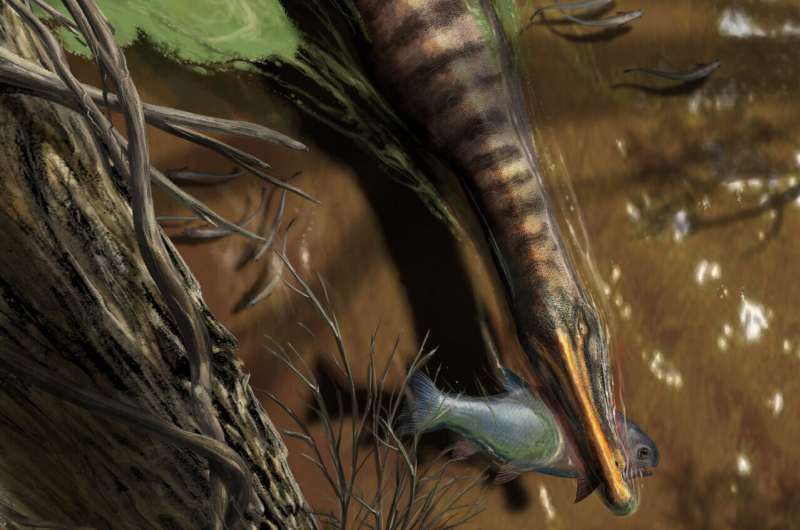
Spinosaurus is the biggest carnivorous dinosaur ever discovered—even bigger than T. rex—but the way it hunted has been a subject of debate for decades. It's hard to guess the behavior of an animal that we only know from fossils; based on its skeleton, some scientists have proposed that Spinosaurus could swim, but others believe that it just waded in the water like a heron. Since looking at the anatomy of spinosaurid dinosaurs wasn't enough to solve the mystery, a group of paleontologists are publishing a new study in Nature that takes a different approach: examining the density of their bones. By analyzing the density of spinosaurid bones and comparing them to other animals like penguins, hippos, and alligators, the team found that Spinosaurus and its close relative Baryonyx had dense bones that likely would have allowed them to submerge themselves underwater to hunt. Meanwhile, another related dinosaur called Suchomimus had lighter bones that would have made swimming more difficult, so it likely waded instead or spent more time on land like other dinosaurs.
"The fossil record is tricky—among spinosaurids, there are only a handful of partial skeletons, and we don't have any complete skeletons for these dinosaurs," says Matteo Fabbri, a postdoctoral researcher at the Field Museum and the lead author of the study in Nature. "Other studies have focused on interpretation of anatomy, but clearly if there are such opposite interpretations regarding the same bones, this is already a clear signal that maybe those are not the best proxies for us to infer the ecology of extinct animals."
All life initially came from the water, and most groups of terrestrial vertebrates contain members that have returned to it—for instance, while most mammals are land-dwellers, we've got whales and seals that live in the ocean, and other mammals like otters, tapirs, and hippos that are semi-aquatic. Birds have penguins and cormorants; reptiles have alligators, crocodiles, marine iguanas, and sea snakes. For a long time, non-avian dinosaurs (the dinos that didn't branch off into birds) were the only group that didn't have any water-dwellers. That changed in 2014, when a new Spinosaurus skeleton was described by Nizar Ibrahim at the University of Portsmouth.
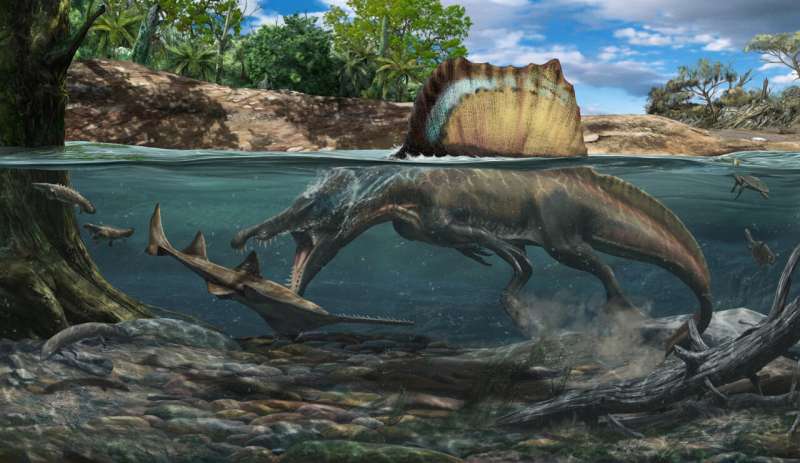
Scientists already knew that spinosaurids spent some time by water—their long, croc-like jaws and cone-shaped teeth are similar to other aquatic predators', and some fossils had been found with bellies full of fish. But the new Spinosaurus specimen described in 2014 had retracted nostrils, short hind legs, paddle-like feet, and a fin-like tail: all signs that pointed to an aquatic lifestyle. But researchers have continued to debate whether spinosaurids actually swam for their food or if they just stood in the shallows and dipped their heads in to snap up prey. This continued back-and-forth led Fabbri and his colleagues to try to find another way to solve the problem.
"The idea for our study was, okay, clearly we can interpret the fossil data in different ways. But what about the general physical laws?" says Fabbri. "There are certain laws that are applicable to any organism on this planet. One of these laws regards density and the capability of submerging into water."
Across the animal kingdom, bone density is a tell in terms of whether that animal is able to sink beneath the surface and swim. "Previous studies have shown that mammals adapted to water have dense, compact bone in their postcranial skeletons," says Fabbri. Dense bone works as buoyancy control and allows the animal to submerge itself.
"We thought, okay, maybe this is the proxy we can use to determine if spinosaurids were actually aquatic," says Fabbri.
-
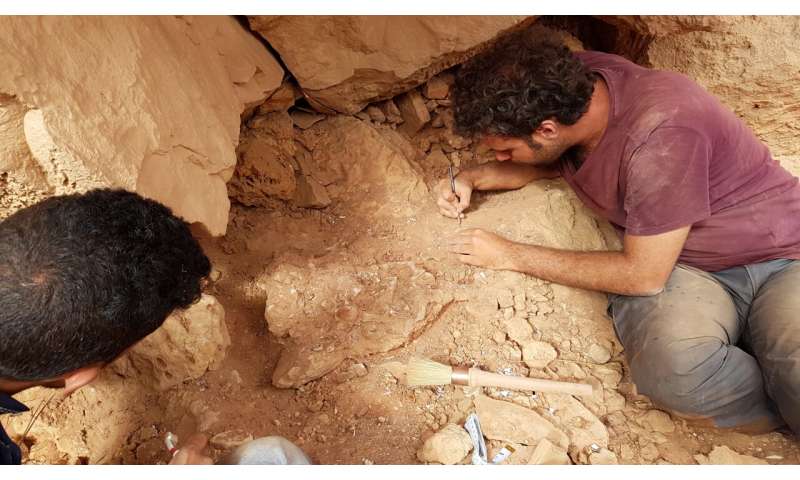
Lead author Matteo Fabbri doing fieldwork. Credit: Diego Mattarelli -
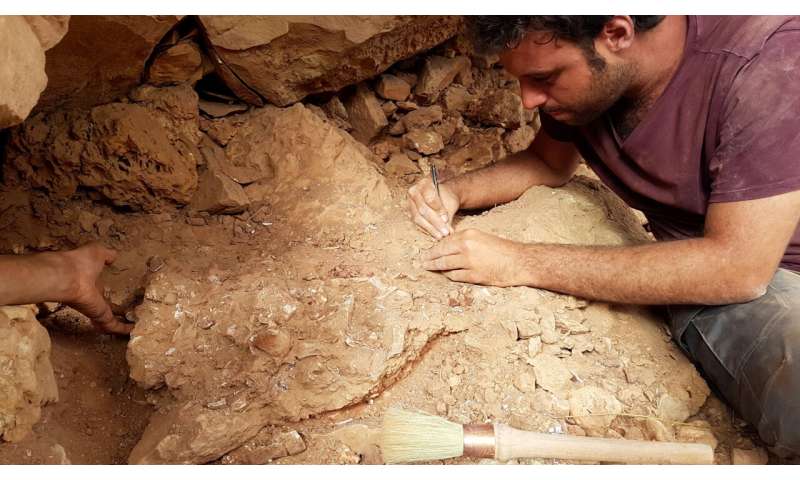
Closeup of lead author Matteo Fabbri doing fieldwork. Credit: Diego Mattarelli
Fabbri and his colleagues, including co-corresponding authors Guillermo Navalón at Cambridge University and Roger Benson at Oxford University, put together a dataset of femur and rib bone cross-sections from 250 species of extinct and living animals, both land-dwellers and water-dwellers. The researchers compared these cross-sections to cross-sections of bone from Spinosaurus and its relatives Baryonyx and Suchomimus. "We had to divide this study into successive steps," says Fabbri. "The first one was to understand if there is actually a universal correlation between bone density and ecology. And the second one was to infer ecological adaptations in extinct taxa" Essentially, the team had to show a proof of concept among animals that are still alive that we know for sure are aquatic or not, and then applied them to extinct animals that we can't observe.
When selecting animals to include in the study, the researchers cast a wide net. "We were looking for extreme diversity," says Fabbri. "We included seals, whales, elephants, mice, hummingbirds. We have dinosaurs of different sizes, extinct marine reptiles like mosasaurs and plesiosaurs. We have animals that weigh several tons, and animals that are just a few grams. The spread is very big."
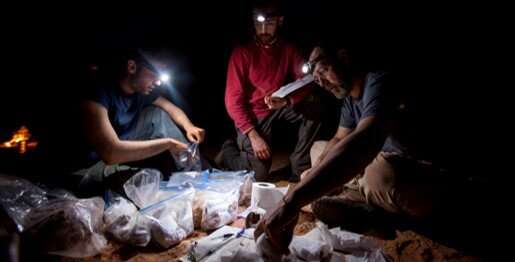
This menagerie of animals revealed a clear link between bone density and aquatic foraging behavior: animals that submerge themselves underwater to find food have bones that are almost completely solid throughout, whereas cross-sections of land-dwellers' bones look more like donuts, with hollow centers. "There is a very strong correlation, and the best explanatory model that we found was in the correlation between bone density and sub-aqueous foraging. This means that all the animals that have the behavior where they are fully submerged have these dense bones, and that was the great news," says Fabbri.
When the researchers applied spinosaurid dinosaur bones to this paradigm, they found that Spinosaurus and Baryonyx both had the sort of dense bone associated with full submersion. Meanwhile, the closely related Suchomimus had hollower bones. It still lived by water and ate fish, as evidenced by its crocodile-mimic snout and conical teeth, but based on its bone density, it wasn't actually swimming.
Other dinosaurs, like the giant long-necked sauropods also had dense bones, but the researchers don't think that meant they were swimming. "Very heavy animals like elephants and rhinos, and like the sauropod dinosaurs, have very dense limb bones, because there's so much stress on the limbs," explains Fabbri. "That being said, the other bones are pretty lightweight. That's why it was important for us to look at a variety of bones from each of the animals in the study." And while there are limitations to this kind of analysis, Fabbri is excited by the potential for this study to tell us about how dinosaurs lived.
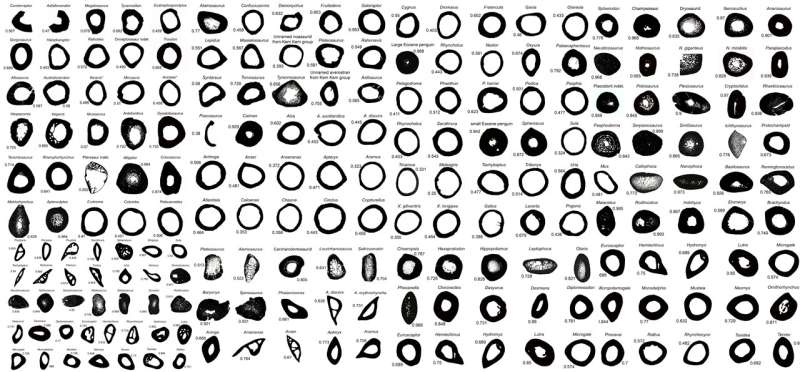
"One of the big surprises from this study was how rare underwater foraging was for dinosaurs, and that even among spinosaurids, their behavior was much more diverse that we'd thought," says Fabbri.
Jingmai O'Connor, a curator at the Field Museum and co-author of this study, says that collaborative studies like this one that draw from hundreds of specimens, are "the future of paleontology. They're very time-consuming to do, but they let scientists shed light onto big patterns, rather than making qualitative observations based on one fossil. It's really awesome that Matteo was able to pull this together, and it requires a lot of patience."
Fabbri also notes that the study shows how much information can be gleaned from incomplete specimens. "The good news with this study is that now we can move on from the paradigm where you need to know as much as you can about the anatomy of a dinosaur to know about its ecology, because we show that there are other reliable proxies that you can use. If you have a new species of dinosaur and you just have only a few bones of it, you can create a dataset to calculate bone density, and at least you can infer if it was aquatic or not."
Explore further
Citation: Dense bones allowed Spinosaurus to hunt underwater, study shows (2022, March 23) retrieved 23 March 2022 from https://phys.org/news/2022-03-dense-bones-spinosaurus-underwater.html
This document is subject to copyright. Apart from any fair dealing for the purpose of private study or research, no part may be reproduced without the written permission. The content is provided for information purposes only.
https://news.google.com/__i/rss/rd/articles/CBMiRWh0dHBzOi8vcGh5cy5vcmcvbmV3cy8yMDIyLTAzLWRlbnNlLWJvbmVzLXNwaW5vc2F1cnVzLXVuZGVyd2F0ZXIuaHRtbNIBAA?oc=5
2022-03-23 16:00:04Z
1353255842
Selasa, 22 Maret 2022
L3Harris' Successful 'Eye' Integration, Extreme Testing Enabled James Webb Space Telescope Images - Business Wire

MELBOURNE, Fla.--(BUSINESS WIRE)--L3Harris Technologies (NYSE:LHX) engineers integrated a complex system of mirrors on NASA’s James Webb Space Telescope, then simulated the harsh conditions of space to rigorously test the functions, ensuring the successful capture of ancient light providing insights into the universe’s origins.
More than a decade of careful, methodical work by L3Harris, dating back to 2003, led to the successful 18-mirror alignment just announced by NASA, confirming Webb’s ‘eye’ is working as designed, resulting in a “fully focused image of a single star.”
After integrating the complex system of mirrors, a team of L3Harris engineers performed a series of optical tests using a cryogenic vacuum chamber at NASA’s Johnson Space Center to assess the telescope’s ability to operate in harsh space conditions. The recent successful image capture proves the L3Harris integration and testing paid off, paving the way for this scientific progress.
“There are no second chances one million miles from Earth,” said Ed Zoiss, president, L3Harris Space and Airborne Systems. “Accurately replicating the environment where the Webb telescope would operate and testing it with increasing fidelity and complexity here on earth was essential to building confidence it would perform flawlessly to support this important scientific mission.” The telescope reached its orbit at the second Lagrange point Jan. 24, one month after launch.
L3Harris engineers integrated the mirrors for the Optical Telescope Element (OTE) - the eye of the telescope observatory, as well as installed the Integrated Science Instrument Module (ISIM) into the OTE structure, resulting in such precise alignment. The OTE will collect light to create sharp images of deep space and light from atmospheres of exoplanets never seen before. The ISIM holds the four science instruments that will gather light delivered by the telescope and produce images and spectra.
Webb is the largest space telescope ever built — two-and-a-half times larger in diameter and six times larger in area than the Hubble Space Telescope. Thousands of engineers and scientists worked on the Webb telescope from an international consortium of NASA, the European Space Agency, the Canadian Space Agency, 300 universities, organizations and companies in 29 U.S. states and 14 countries.
“The James Webb Space Telescope is possible because of engineers, including those at L3Harris, who rigorously engineered elements of the spacecraft,” Zoiss said. “Building, integrating and testing spacecraft and components is a core capability at L3Harris, dating back to the early days of NASA and continuing for new missions.”
L3Harris is building the optical telescope for the Nancy Grace Roman Space Telescope, which will study dark energy, dark matter, exoplanets and infrared astrophysics. The company is also supporting NASA Orion’s first crewed flight, and designing and building the engineering development unit telescopes for the Laser Interferometer Space Antenna, which will demonstrate the ability to measure gravitational waves in space.
Information about L3Harris’ role on the Webb telescope and other missions will be available during the 37th Space Symposium April 4-7 in Colorado Springs, Colo.
About L3Harris Technologies
L3Harris Technologies is an agile global aerospace and defense technology innovator, delivering end-to-end solutions that meet customers’ mission-critical needs. The company provides advanced defense and commercial technologies across space, air, land, sea and cyber domains. L3Harris has more than $17 billion in annual revenue and 47,000 employees, with customers in more than 100 countries. L3Harris.com.
Forward-Looking Statements
This press release contains forward-looking statements that reflect management's current expectations, assumptions and estimates of future performance and economic conditions. Such statements are made in reliance upon the safe harbor provisions of Section 27A of the Securities Act of 1933 and Section 21E of the Securities Exchange Act of 1934. The company cautions investors that any forward-looking statements are subject to risks and uncertainties that may cause actual results and future trends to differ materially from those matters expressed in or implied by such forward-looking statements. Statements about the value or expected value of orders, contracts or programs or about system or technology capabilities are forward-looking and involve risks and uncertainties. L3Harris disclaims any intention or obligation to update or revise any forward-looking statements, whether as a result of new information, future events, or otherwise.
https://news.google.com/__i/rss/rd/articles/CBMisQFodHRwczovL3d3dy5idXNpbmVzc3dpcmUuY29tL25ld3MvaG9tZS8yMDIyMDMyMjAwNTQwMi9lbi9MM0hhcnJpcyVFMiU4MCU5OS1TdWNjZXNzZnVsLSVFMiU4MCU5OEV5ZSVFMiU4MCU5OS1JbnRlZ3JhdGlvbi1FeHRyZW1lLVRlc3RpbmctRW5hYmxlZC1KYW1lcy1XZWJiLVNwYWNlLVRlbGVzY29wZS1JbWFnZXPSAQA?oc=5
2022-03-22 13:00:00Z
1339754876
Senin, 21 Maret 2022
NASA prepares Artemis I rocket for final major test - Xinhua
LOS ANGELES, March 21 (Xinhua) -- NASA engineers and technicians are preparing the Artemis I rocket for its final major test following its arrival at the launch pad for the first time, according to the agency.
The Artemis I Moon rocket - NASA's Space Launch System (SLS) with the Orion spacecraft atop it - has arrived at the launch pad for the first time on Friday, after a nearly 11-hour journey from the Vehicle Assembly Building at NASA's Kennedy Space Center in Florida.
In the coming days, engineers and technicians will prepare the Artemis I rocket for its final major test - the wet dress rehearsal. The approximately two-day test will demonstrate the team's ability to load cryogenic propellants into the rocket, conduct a launch countdown, and practice safely removing propellants at the launch pad, according to NASA.
After the rehearsal, NASA will review data from the test before setting a specific target launch date for the Artemis I launch.
With Artemis, NASA plans to land the first woman and the first person of color on the Moon and establish long-term exploration in preparation for missions to Mars. ■
https://news.google.com/__i/rss/rd/articles/CBMiXmh0dHA6Ly93d3cueGluaHVhbmV0LmNvbS9lbmdsaXNoL25vcnRoYW1lcmljYS8yMDIyMDMyMi8zYjU3NDVmM2QwMTI0MWRiYjY4NmI0ZTM4MGQ5M2U0OC9jLmh0bWzSAQA?oc=5
2022-03-21 18:04:15Z
1308534003
Sabtu, 19 Maret 2022
NASA Spots Gigantic Debris Cloud Created by Clashing Celestial Bodies - SciTechDaily
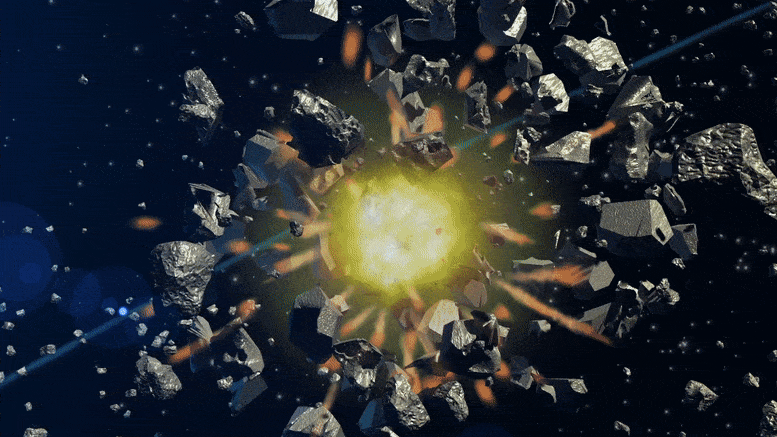
Major smashups between rocky bodies shaped our solar system. Observations of a similar crash give clues about how frequent these events are around other stars.
Most of the rocky planets and satellites in our solar system, including Earth and the Moon, were formed or shaped by massive collisions early in the solar system’s history. By smashing together, rocky bodies can accumulate more material, increasing in size, or they can break apart into multiple smaller bodies.
Astronomers using NASA’s now-retired Spitzer Space Telescope have in the past found evidence of these types of collisions around young stars where rocky planets are forming. But those observations didn’t provide many details about the smashups, such as the size of the objects involved.
In a new study in The Astrophysical Journal, a group of astronomers led by Kate Su of the University of Arizona report the first observations of a debris cloud from one of these collisions as it passed in front of its star and briefly blocked the light. Astronomers call this a transit. Coupled with knowledge about the star’s size and brightness, the observations enabled the researchers to directly determine the size of the cloud shortly after impact, estimate the size of the objects that collided, and watch the speed with which the cloud dispersed.
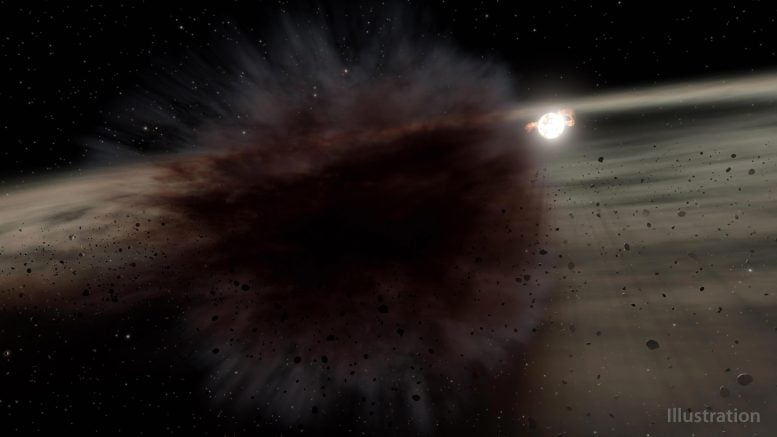
This illustration depicts the result of a collision between two large asteroid-sized bodies. NASA’s Spitzer saw a debris cloud block the star HD 166191, giving scientists details about the smashup that occurred. Credit: NASA/JPL-Caltech
“There is no substitute for being an eyewitness to an event,” said George Rieke, also at the University of Arizona and a coauthor of the new study. “All the cases reported previously from Spitzer have been unresolved, with only theoretical hypotheses about what the actual event and debris cloud might have looked like.”
Beginning in 2015, a team led by Su started making routine observations of a 10 million-year-old star called HD 166191. Around this early time in a star’s life, dust left over from its formation has clumped together to form rocky bodies called planetesimals – seeds of future planets. Once the gas that previously filled the space between those objects has dispersed, catastrophic collisions between them become common.
Anticipating they might see evidence of one of these collisions around HD 166191, the team used Spitzer to conduct more than 100 observations of the system between 2015 and 2019. While the planetesimals are too small and distant to resolve by telescope, their smashups produce large amounts of dust. Spitzer detected infrared light – or wavelengths slightly longer than what human eyes can see. Infrared is ideal for detecting dust, including the debris created by protoplanet collisions.
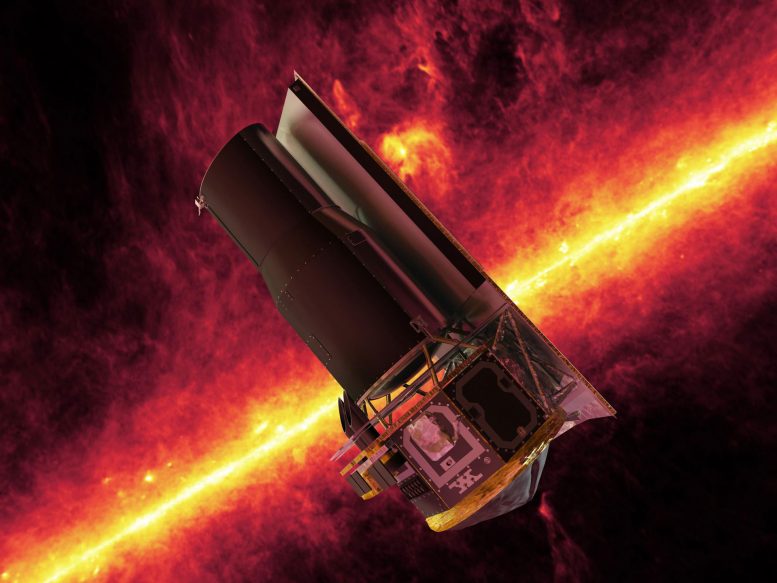
This image shows an artist’s impression of the Spitzer Space Telescope. The background shows an infrared image from Spitzer of the plane of the Milky Way galaxy. Credits: NASA/JPL
In mid-2018, the space telescope saw the HD 166191 system become significantly brighter, suggesting an increase in debris production. During that time, Spitzer also detected a debris cloud blocking the star. Combining Spitzer’s observation of the transit with observations by telescopes on the ground, the team could deduce the size and shape of the debris cloud.
Their work suggests the cloud was highly elongated, with a minimum estimated area three times that of the star. However, the amount of infrared brightening Spitzer saw suggests only a small portion of the cloud passed in front of the star and that the debris from this event covered an area hundreds of times larger than that of the star.
To produce a cloud that big, the objects in the main collision must have been the size of dwarf planets, like Vesta in our solar system – an object 330 miles (530 kilometers) wide located in the main asteroid belt between Mars and Jupiter. The initial clash generated enough energy and heat to vaporize some of the material. It also set off a chain reaction of impacts between fragments from the first collision and other small bodies in the system, which likely created a significant amount of the dust Spitzer saw.
Over the next few months, the large dust cloud grew in size and became more translucent, indicating that the dust and other debris were quickly dispersing throughout the young star system. By 2019, the cloud that passed in front of the star was no longer visible, but the system contained twice as much dust as it had before Spitzer spotted the cloud. This information, according to the paper’s authors, can help scientists test theories about how terrestrial planets form and grow.
“By looking at dusty debris disks around young stars, we can essentially look back in time and see the processes that may have shaped our own solar system,” said Su. “Learning about the outcome of collisions in these systems, we may also get a better idea of how frequently rocky planets form around other stars.”
Reference: “A Star-sized Impact-produced Dust Clump in the Terrestrial Zone of the HD 166191 System” by Kate Y. L. Su, Grant M. Kennedy, Everett Schlawin, Alan P. Jackson and G. H. Rieke, 10 March 2022, The Astrophysical Journal.
DOI: 10.3847/1538-4357/ac4bbb
More About Spitzer
The entire body of scientific data collected by Spitzer during its lifetime is available to the public via the Spitzer data archive, housed at the Infrared Science Archive at IPAC at Caltech in Pasadena, California. JPL, a division of Caltech, managed Spitzer mission operations for NASA’s Science Mission Directorate in Washington. Science operations were conducted at the Spitzer Science Center at IPAC at Caltech. Spacecraft operations were based at Lockheed Martin Space in Littleton, Colorado.
https://news.google.com/__i/rss/rd/articles/CBMiX2h0dHBzOi8vc2NpdGVjaGRhaWx5LmNvbS9uYXNhLXNwb3RzLWdpZ2FudGljLWRlYnJpcy1jbG91ZC1jcmVhdGVkLWJ5LWNsYXNoaW5nLWNlbGVzdGlhbC1ib2RpZXMv0gEA?oc=5
2022-03-19 19:47:10Z
CBMiX2h0dHBzOi8vc2NpdGVjaGRhaWx5LmNvbS9uYXNhLXNwb3RzLWdpZ2FudGljLWRlYnJpcy1jbG91ZC1jcmVhdGVkLWJ5LWNsYXNoaW5nLWNlbGVzdGlhbC1ib2RpZXMv0gEA